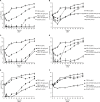In vitro antibacterial effect of fosfomycin combination therapy against colistin-resistant Klebsiella pneumoniae
- PMID: 29731646
- PMCID: PMC5926077
- DOI: 10.2147/IDR.S160474
In vitro antibacterial effect of fosfomycin combination therapy against colistin-resistant Klebsiella pneumoniae
Abstract
Objectives: Colistin is still a "last-resort" antibiotic used to manage human infections due to multidrug-resistant (MDR) Klebsiella pneumoniae. However, colistin-resistant K. pneumoniae (CR-Kp) isolates emerged a decade ago and had a worldwide distribution. The purpose of this study was to evaluate the genetic data of CR-Kp and identify the antibacterial activity of fosfomycin (FM) alone and in combination with amikacin (AMK) or colistin (COL) against CR-Kp in vitro.
Methods: Three clinical CR-Kp isolates from three patients were collected. Whole-genome sequencing and bioinformatics analysis were performed. The Pharmacokinetics Auto Simulation System 400, by simulating human pharmacokinetics in vitro, was employed to simulate FM, AMK, and COL alone and in combination. Different pharmacodynamic parameters were calculated for determining the antimicrobial effect.
Results: Whole-genome sequencing revealed that none of the three isolates contain mcr gene and that no insertion was found in pmrAB, phoPQ, or mgrB genes. We found the antibacterial activity of AMK alone was more efficient than FM or COL against CR-Kp. The area between the control growth and antibacterial killing curves of FM (8 g every 8 hours) combined with AMK (15 mg/kg once daily) was higher than 170 LogCFU/mL·h-1. In addition, the area between the control growth and antibacterial killing curves of FM (8 g every 8 hours) combined with COL (75,000 IU/kg every12 hours) was higher than that of monotherapies (>100 LogCFU/mL·h-1 vs <80 LogCFU/mL·h-1).
Conclusion: FM (8 g every 8 hours) combined with AMK (15 mg/kg once daily) was effective at maximizing bacterial killing against CR-Kp.
Keywords: Pharmacokinetics; colistin-resistant Klebsiella pneumoniae; combination therapy; monotherapy; pharmacodynamics.
Conflict of interest statement
Disclosure The authors report no conflicts of interest in this work.
Figures


Similar articles
-
In vitro Pharmacokinetics/Pharmacodynamics Evaluation of Fosfomycin Combined with Amikacin or Colistin against KPC2-Producing Klebsiella pneumoniae.Front Cell Infect Microbiol. 2017 Jun 16;7:246. doi: 10.3389/fcimb.2017.00246. eCollection 2017. Front Cell Infect Microbiol. 2017. PMID: 28670570 Free PMC article.
-
Synergistic activity of fosfomycin-meropenem and fosfomycin-colistin against carbapenem resistant Klebsiella pneumoniae: an in vitro evidence.Future Sci OA. 2020 Feb 26;6(4):FSO461. doi: 10.2144/fsoa-2019-0074. Future Sci OA. 2020. PMID: 32257374 Free PMC article.
-
In vitro synergistic activity of fosfomycin in combination with meropenem, amikacin and colistin against OXA-48 and/or NDM-producing Klebsiella pneumoniae.J Chemother. 2020 Sep;32(5):237-243. doi: 10.1080/1120009X.2020.1745501. Epub 2020 Mar 31. J Chemother. 2020. PMID: 32228228
-
The Antibacterial Activity of Kaempferol Combined with Colistin against Colistin-Resistant Gram-Negative Bacteria.Microbiol Spectr. 2022 Dec 21;10(6):e0226522. doi: 10.1128/spectrum.02265-22. Epub 2022 Oct 31. Microbiol Spectr. 2022. PMID: 36314964 Free PMC article.
-
MgrB Alterations Mediate Colistin Resistance in Klebsiella pneumoniae Isolates from Iran.Front Microbiol. 2017 Dec 18;8:2470. doi: 10.3389/fmicb.2017.02470. eCollection 2017. Front Microbiol. 2017. PMID: 29326662 Free PMC article.
Cited by
-
Evaluation of the Synergistic Antibacterial Effects of Fosfomycin in Combination with Selected Antibiotics against Carbapenem-Resistant Acinetobacter baumannii.Pharmaceuticals (Basel). 2021 Feb 25;14(3):185. doi: 10.3390/ph14030185. Pharmaceuticals (Basel). 2021. PMID: 33668905 Free PMC article.
-
Present and Future Perspectives on Therapeutic Options for Carbapenemase-Producing Enterobacterales Infections.Microorganisms. 2021 Mar 31;9(4):730. doi: 10.3390/microorganisms9040730. Microorganisms. 2021. PMID: 33807464 Free PMC article. Review.
-
The "Old" and the "New" Antibiotics for MDR Gram-Negative Pathogens: For Whom, When, and How.Front Public Health. 2019 Jun 11;7:151. doi: 10.3389/fpubh.2019.00151. eCollection 2019. Front Public Health. 2019. PMID: 31245348 Free PMC article. Review.
-
Fosfomycin as Partner Drug for Systemic Infection Management. A Systematic Review of Its Synergistic Properties from In Vitro and In Vivo Studies.Antibiotics (Basel). 2020 Aug 10;9(8):500. doi: 10.3390/antibiotics9080500. Antibiotics (Basel). 2020. PMID: 32785114 Free PMC article. Review.
References
-
- Karaiskos I, Souli M, Galani I, Giamarellou H. Colistin: still a lifesaver for the 21st century? Expert Opin Drug Metab Toxicol. 2017;13(1):59–71. - PubMed
-
- Liu YY, Wang Y, Walsh TR, et al. Emergence of plasmid-mediated colistin resistance mechanism MCR-1 in animals and human beings in China: a microbiological and molecular biological study. Lancet Infect Dis. 2015;16(2):161–168. - PubMed
LinkOut - more resources
Full Text Sources
Other Literature Sources

